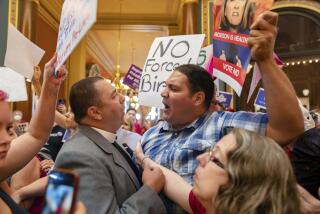In Abortion Ruling, High Court Finds Middle Path
- Share via
WASHINGTON — The Supreme Court, in a rare unanimous decision on abortion, said Wednesday that states may require girls under age 18 to tell a parent at least two days before having an abortion so long as the law also permits doctors to act quickly in medical emergencies.
The ruling resolves, for now, a New Hampshire case without significantly changing the law.
Justice Sandra Day O’Connor, in what may be her final opinion, set out a compromise solution that gives both sides most of what they asked for.
State lawmakers wanted to ensure that a pregnant girl would speak to a parent at least 48 hours before going ahead with an abortion. “States unquestionably have the right to require parental involvement when a minor considers terminating her pregnancy,” O’Connor said.
Forty-four states have laws that give parents a role in the abortion decision, she said. (California is not one of them.)
However, New Hampshire’s Legislature did not provide exemptions for medical emergencies.
“In some very small percentage of cases, pregnant minors, like adult women, need immediate abortions to avert serious and often irreversible damage to their health,” O’Connor said.
States cannot restrict access to abortions that are “necessary, in appropriate medical judgment, for preservation of the life or health of the mother,” she said.
O’Connor described both principles as established and not necessarily in conflict.
However, two lower courts had voided the entire New Hampshire law because it did not include the exception for medical emergencies. O’Connor called this a “blunt remedy” that went too far. “We agree with New Hampshire that the lower courts need not have invalidated the law wholesale,” she said.
The justices sent the dispute back to the lower courts for fixes in the law. The state Legislature could amend its law to make clear that the required waiting period did not apply in cases of medical emergencies. Or the judges could issue an order saying the law permitted doctors to act immediately in emergencies.
The New Hampshire case -- Ayotte vs. Planned Parenthood -- marked the first time in six years that the high court had taken up an abortion case, and many had predicted the justices would be sharply divided.
But during oral arguments in late November, it became clear the dispute could be settled without changing the law. Chief Justice John G. Roberts Jr. proposed a middle ground to save the law by fixing it slightly, and the idea apparently met with the approval of all the justices.
“We do not revisit our abortion precedents today,” O’Connor began her opinion, making clear this would not be a major ruling.
Advocates on both sides of the abortion divide applauded the decision.
“The Supreme Court got it right in determining that the appeals court went too far by declaring the parental notification law in New Hampshire unconstitutional,” said Jay Sekulow, chief counsel for the American Center for Law and Justice, a Christian legal foundation. “Parents have a critical role to play in the health and well-being of their children, especially when considering an abortion.”
The Planned Parenthood Federation and the American Civil Liberties Union welcomed the court’s ruling that doctors must be permitted to act immediately in cases of a medical emergency. “Today’s decision tells politicians that they cannot jeopardize women’s health when they pass abortion laws,” said ACLU lawyer Jennifer Dalven, who argued the case before the high court.
Wednesday’s ruling probably does not signal the court’s coming-together on the abortion issue. Indeed, this moment of good feelings may not last the week.
The justices have been considering whether to hear the Bush administration’s appeal in support of a federal ban on an abortion procedure some Republican lawmakers have described as gruesome and inhumane.
In 2003, Congress outlawed the procedure, called “partial-birth abortion” by its opponents, and President Bush signed the ban. But two lower courts struck down the law, saying -- as has the Supreme Court in the past -- that the procedure is sometimes the safest abortion method for women in mid- and late pregnancy.
The Bush administration, represented by U.S. Solicitor General Paul D. Clement, appealed to the Supreme Court last fall. He said Congress had determined that the method was “never medically indicated,” and he urged the court to respect Congress’ judgment.
The issue is similar to New Hampshire’s: Must an abortion law include an exception for doctors to act to protect the health of the patient?
When the justices last ruled on “partial-birth” abortions, they struck down a state’s ban because it failed to protect the health of the woman. But the ruling came on a 5-4 vote, with O’Connor in the majority.
On Friday, in what could be O’Connor’s last meeting with the justices, they will discuss behind closed doors whether to hear the Bush administration’s appeal to institute the “partial-birth” abortion ban, in Gonzales vs. Carhart.
If at least four justices vote to hear the appeal, the case will be argued in April. By then, Samuel A. Alito Jr. probably will have succeeded O’Connor.
More to Read
Sign up for Essential California
The most important California stories and recommendations in your inbox every morning.
You may occasionally receive promotional content from the Los Angeles Times.














